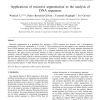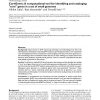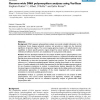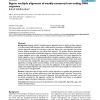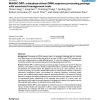CANDC
2002
ACM
14 years 1 months ago
2002
ACM
Recursive segmentation is a procedure that partitions a DNA sequence into domains with a homogeneous composition of the four nucleotides A, C, G and T. This procedure can also be ...
BMCBI
2002
14 years 1 months ago
2002
Background: Improvements in DNA sequencing technology and methodology have led to the rapid expansion of databases comprising DNA sequence, gene and genome data. Lower operational...
BMCBI
2004
14 years 1 months ago
2004
Background: The Distributed Annotation System (DAS) allows merging of DNA sequence annotations from multiple sources and provides a single annotation view. A straightforward way t...
BMCBI
2004
14 years 1 months ago
2004
Background: The program InDeVal was originally developed to help researchers find known regions of insertion/deletion activity (with the exception of isolated single-base indels) ...
BMCBI
2004
14 years 1 months ago
2004
Background: Mutations in rpoB, the gene encoding the subunit of DNA-dependent RNA polymerase, are associated with rifampin resistance in Mycobacterium tuberculosis. Several studi...
BMCBI
2005
14 years 1 months ago
2005
Background: Understanding transcriptional regulation of gene expression is one of the greatest challenges of modern molecular biology. A central role in this mechanism is played b...
ARTMED
2005
14 years 1 months ago
2005
Codons refer to those parts in a DNA complex encoded towards forming a desired set of proteins. Also coexist in the DNA are noncodons (or "junk" codons) whose functions ...
BMCBI
2006
14 years 1 months ago
2006
Background: DNA sequence polymorphisms analysis can provide valuable information on the evolutionary forces shaping nucleotide variation, and provides an insight into the function...
BMCBI
2006
14 years 1 months ago
2006
Background: Existing tools for multiple-sequence alignment focus on aligning protein sequence or protein-coding DNA sequence, and are often based on extensions to Needleman-Wunsch...
BMCBI
2006
14 years 1 months ago
2006
Background: Processing raw DNA sequence data is an especially challenging task for relatively small laboratories and core facilities that produce as many as 5000 or more DNA seque...
